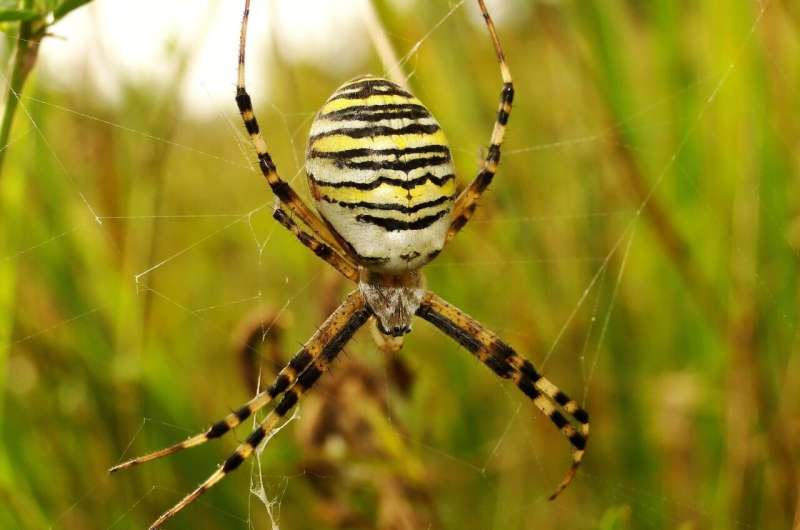Spiders 'smell' with their legs, new research finds

Spiders have always lived alongside humans, so it's surprising how much we still don't know about them. One long-standing mystery was related to how spiders detect smells. Now, our latest research has finally uncovered the secret.
In a study in the Proceedings of the National Academy of Sciences, we demonstrated that male spiders use olfactory hairs called wall-pore sensilla on their legs as a "nose" to detect the sex pheromones released by female spiders.
Our discovery puts an end to a decade-long search for these elusive sensilla, which have now been both identified and mapped. It also opens up opportunities for in-depth studies on the mechanism underlying spiders' olfaction.
Although spiders—which have been evolving for about 400m years—are renowned and some, like jumping spiders, , surprisingly little is known about their sense of smell. There has been showing that spiders can detect odors such as sex pheromones, but two big questions remain unanswered.
First, as spiders do not have antennae as insects, what is their primary olfactory organ? Second, previous studies suggested that , the specialized structures that insects rely on for smell. Without these, how do spiders detect odors at all?
Our study has solved these long-standing questions. We discovered previously overlooked wall-pore sensilla on the walking legs of male wasp spiders (Argiope bruennichi) and demonstrated that they can use them to detect airborne sex pheromones with high sensitivity.
We showed that the wall-pore sensilla are not unique to wasp spiders but are prevalent across the spider tree of life.
Under the microscope
We examined male and female by high-resolution scanning electron microscopy. We discovered thousands of wall-pore sensilla on all walking legs of male spiders and revealed specific features of these sensilla. In fact, they are different from those found in insects and other arthropods.
The wall-pore sensilla are located on the upper part of the male's legs (close to the body), areas that hardly come in contact with the surface when spiders walk, capture prey or mate. This is complementary with the distribution of "putative gustatory sensilla" (the tip-pore sensilla) found in the lower part of the legs, which frequently make contact with the surface.
This distribution pattern already suggested the role of wall-pore sensilla in detecting airborne odors (olfaction). Interestingly, wall-pore sensilla were found exclusively in adult male spiders, not in juvenile males or females, which strongly indicates their function in mate searching and recognition.
Evidence of neuronal activities
A. bruennichi is one of the few spider species in which the chemical structure of the sex pheromone . Female spiders release gaseous pheromones that attract males from a distance.
We decided to test whether the wall-pore sensilla responds to the pheromone compound. In these experiments, we carefully mounted live male spiders under a microscope and poked a recording electrode into the base of single-wall-pore sensilla.
We then exposed each sensillum to a puff containing the pheromone compound. We found that even a tiny amount of the pheromone compound—just 20 nanograms—was sufficient to elicit a clear response as a burst of activity in neuronal cells from a wall-pore sensillum, and the response became stronger as the dose increased. We consistently observed the response of wall-pore sensilla to the pheromone compound, regardless of which leg pair was tested.
Our results show that spiders' olfactory sensilla are incredibly sensitive, comparable to the most sensitive sex pheromone communication systems in insects. The thousands of sensilla on all walking legs will enable male spiders to detect even the faintest traces of sex pheromones in the air.
Other species
To explore the broader presence of wall-pore sensilla, we examined 19 additional species spanning 16 families across the spider tree of life. We found that wall-pore sensilla occur in most species, and were also specific to males.
However, the sensilla are absent in basally branching spider groups such as the found in Asia. The pattern we found suggests that wall-pore sensilla evolved independently multiple times within spiders and were lost in some lineages.
Our study paves the way for exciting future discoveries about how spiders perceive the world through olfaction. Many intriguing questions await further investigation.
How do female spiders smell without wall-pore sensilla? And beyond sex pheromones, what other chemicals can spiders detect and how are these relevant to their behavior and ecology? Also, what is the molecular and neural basis of spiders' olfaction? Finally, how has the sense of smell evolved across the vast diversity of spider species?
These questions set the stage for an exciting new chapter in our understanding of spider biology.
More information: Mohammad Belal Talukder et al, Olfaction with legs—Spiders use wall-pore sensilla for pheromone detection, Proceedings of the National Academy of Sciences (2025).
Journal information: Proceedings of the National Academy of Sciences
Provided by The Conversation
This article is republished from under a Creative Commons license. Read the .![]()



















